

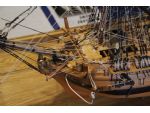

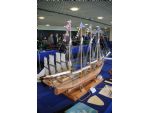


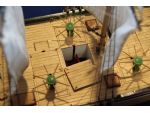
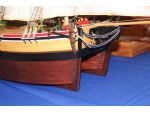

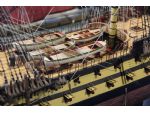
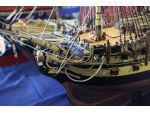



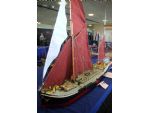




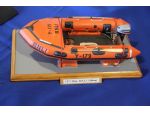
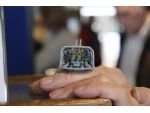

Model Engineer Exhibition 2013
COLIN BISHOP Reports
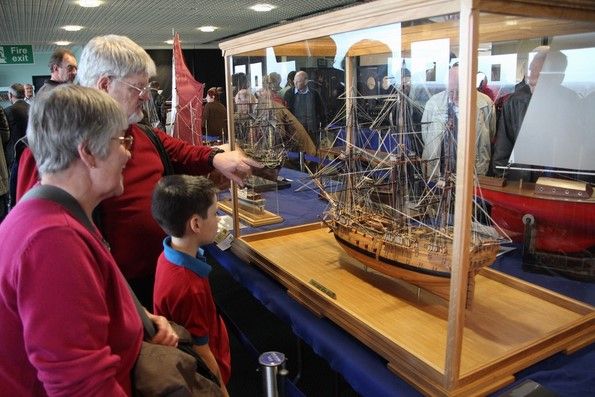
For the first time in more years than I care to remember, I was not on the judging panel this year due to a prior commitment and this report is therefore written from a visitor viewpoint. I will not be commenting on the judging or mentioning all the models in detail as I have no idea of what discussions took place and I am not a believer in second guessing the judging conclusions of others. The 2013 Model Engineer Exhibition, the world's longest running model engineering show, was held at Sandown Park Racecourse over three days just before Christmas.
In line with recent trends, the competition side continues to take a subdued role which is to some extent compensated for by the marine models on the several club stands present.
Personally I do now rather wonder about the scale related competition side of our hobby as there appears to be less and less appetite on the part of potential entrants to participate. You can visit the big exhibition at Warwick and see literally hundreds of superb marine models on display, but only a very tiny percentage appear in the remaining competitions around the country.
There is also the issue that the rules originally drawn up to govern model boat judging have to a great extent been rendered outdated by changes in the hobby and technical developments. When I first started boat modelling back in the stone age(!) you either made everything yourself or you bought a not very sophisticated kit. This state of affairs remained largely unchanged up to around the early 1980's except that the quality of kits began to improve, especially with the introduction of white metal fittings. Now of course your model boating comes in as many flavours as you could possibly wish for with a huge range of high quality kits leading the way supplemented by GRP hulls and fittings, ARTR (Almost Ready to Run) and RTR (Ready to Run) models which you can often operate straight out of the box (for a while at least in some cases!). Traditional ‘scratch building’ has now become very much a niche interest and its exponents often now combine scratch construction with purchased fittings to save time and effort where this will not detract from the finished model. All this makes it very difficult to frame fair sets of competition rules and things are becoming even more complicated when people use computer facilities to design items which are then photo etched or even 3D printed by a third party.
But you can’t put the clock back as this is the reality of today’s model boating and must be accepted, but it does drive a coach and horses through the old competition rule structures which can now really only be applied to more traditional types of model boat building, hence I suspect the reason for the generally low entries in those competitions which still remain.
But it is not all doom and gloom! As long as the type of modelling you do ‘floats your boat’ then that is all that really matters, but us grizzled old veterans do look back fondly to the ‘glory days’ of the 1970's when people did amazing things with very limited resources, but then the people in the Bronze Age probably said just the same about their flint knapping Stone Age predecessors!
This year’s exhibition saw the competition entries and model boat clubs moved upstairs instead of being displayed in the end extension of Sandown Park. This gave good natural light during the day and was also well lit when it became darker.
The competition models
On entering the competition entry room my attention was immediately caught by the large glass case containing Patrick Puttock’s Gold Medal winning model of the 50 gun ship of the line HMS Isis to 1:64 scale. These 4th Rates were the smallest line of battle ships and became obsolescent after the 1750's as being unable to stand up to the larger 74 gun 3rd Rates and less versatile than the new large 5th Rate frigates. Mr. Puttock’s model was built as far as possible in the same way as the full-size ship using the original plans held by the National Maritime Museum with sections of deck planking left off to show the interior construction.
Whilst examining the models I fell into conversation with Michael Kenard who talked me through the finer points of his American four masted schooner Bertha L. Downs of 1908. This is was the first marine model he had built and it gained him a Silver Medal. The ship is the subject of Basil Greenhill’s book in the Anatomy of the Ship series and this was an excellent first effort.
Alan Ludbrook likes to seek out and depict unusual prototypes and I have seen his work at both the Model Engineer Exhibition and at the Society of Model Shipwrights’ biennial shows. His latest work is the intriguing ‘Experiment’ of Leith of 1788 built by Patrick Miller and offered to the King of Sweden. This five masted vessel featured catamaran hulls between which were mounted five paddle wheels turned by bevel gearing from deck mounted capstans. These apparently propelled her at 4.3 knots until the crew rapidly became exhausted! It was however an innovative approach when you consider the prevalence of catamaran hulled vessels today, but back then it was rather in advance of the available technology. Alan’s excellent model was awarded a Silver Medal.
The other Gold Medal of the exhibition went to another wooden wall, this time Robert Mullan’s model of the 64 gun ship HMS Agamemnon of 1781, also known as ‘Nelson’s Favourite’ as he commanded her between 1793 and 1796, participating in several notable actions in the Mediterranean and always referred to her as his favourite ship. In this instance, the model was constructed from the JoTiKa Nelson’s Navy range kit and Mr. Mullan’s model illustrates just how close you can get to museum standard with the best of today’s kit offerings.
This year, the Association of Model Barge Owners had a club stand and member Richard Chesney’s impressive ‘Lady Jane’ appeared in the competition where it was awarded a Bronze Medal.
At the other end of the scale there were two lovely miniatures. Roger Hoare made a welcome return with his liner RMS Campania in the Loan Class. Originally built for Cunard in 1893, the vessel was depicted as in 1905. Although most noted as a Blue Riband winning Atlantic express liner she was taken over by the Admiralty at the end of her career and converted into a seaplane carrier to scout for the fleet, although she missed Jutland, not having received the signal to sail! In 1918 this much modified ship had the misfortune to drag her anchors in a gale and fall across the bow of the battleship Royal Oak opening a rent in her hull as a result of which she sank a few hours later.
Robin Lee’s miniature also featured a ship converted to naval service. MV Glenroy, built for Alfred Holt’s Glen Line in 1938, had a high service speed of 18 knots and after the outbreak of WW2 was converted, initially into a fleet supply ship, then an Infantry Assault Ship and later into a Landing Ship Infantry. She had a distinguished wartime career which included the Normandy Landings and was damaged on a number of occasions. Following the war she returned to peacetime service and was finally scrapped in 1966. Robin’s model was deservedly awarded a Silver Medal.
Conclusion
As in previous years, there were several well populated club stands and I had the opportunity of speaking so several old friends, including Alex McFadyen who is still beavering away on his giant model of the French battleship Richelieu and he had brought along some of the fittings to display. I am very much looking forward to seeing the completed model in due course. The Model Engineer Exhibition is 'what it says on the tin', with the model boat element being part of it all. The show was seemingly very well attended, judging by the number of cars in the car parks and the trade stands, although model engineering biased, had much of value to us model boat enthusiasts.
Want the latest issue of Model Boats? Use our magazine locator link to find your nearest stockist!
 Make sure you never miss out on the latest news, product reviews and competitions with our free RSS feed
Make sure you never miss out on the latest news, product reviews and competitions with our free RSS feed

We welcome well written contributions from Website members on almost any aspect of Model Boating with a particular emphasis on practical hints, tips, experience and builds.
In order to maintain a consistent standard and format, all suggestions should first be sent to me by Personal Message for approval in principle. Only a very limited amount of time is available for editing contributions into a suitable format for placing on the website so it is important that the material is well presented, lucid and free from obvious spelling errors. I think it goes without saying that contributions should be illustrated by appropriate photos. I shall be happy to give advice on this.
The Member Contribution area offers space for short informative mini articles which would not normally find a place in Model Boats magazine. It is an opportunity for Website Members to freely share their expertise and experience but I am afraid that virtue is its own reward as there is no budget to offer more material recompense!
I look forward to receiving your suggestions.
Colin Bishop - Website Editor
Model Boats Magazine
- Landing Craft Mini PLan
- Riva Aquarama Build
- Scale Colour, Sound & Speed
Digital Editions
- Access your digital editions
Subscribe Now
- Every issue delivered right to your door
Renew Now
- Save & never miss an issue!











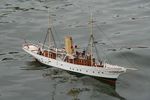
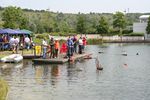

 Register
Register Log-in
Log-in



